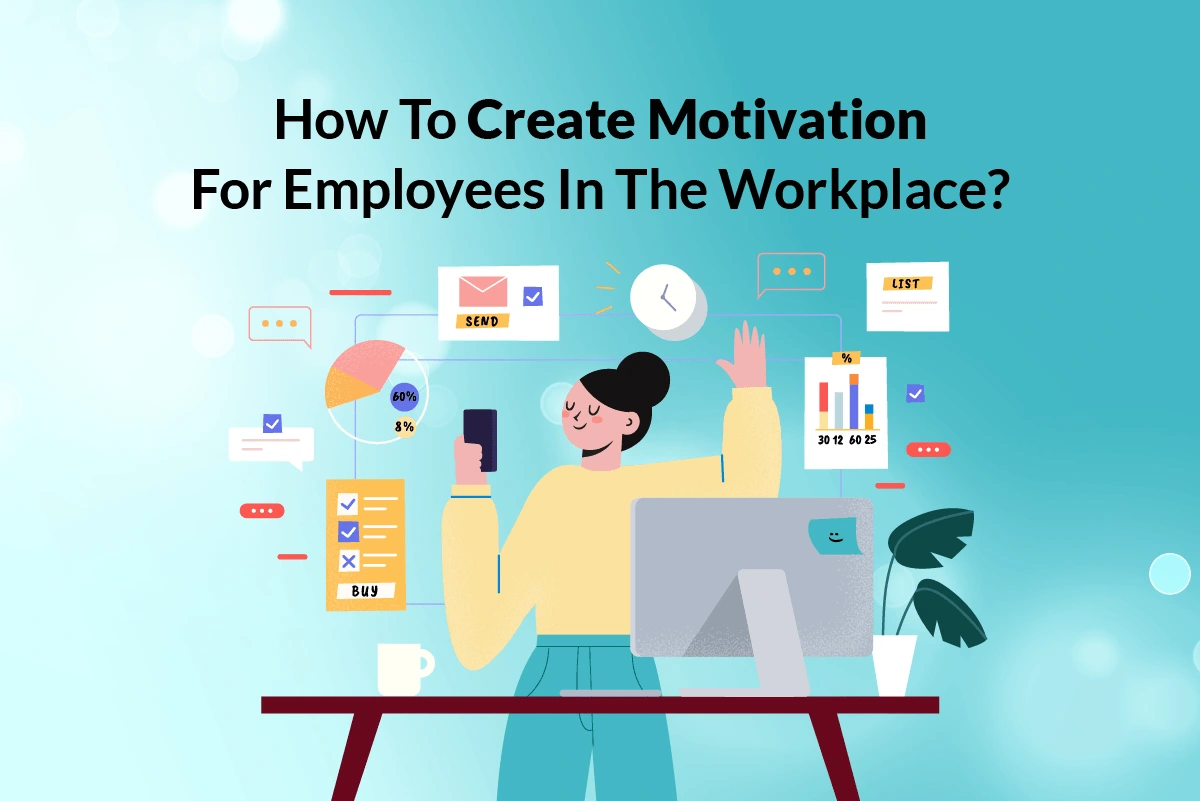Creating motivation for employees in the workplace can often seem difficult; however, it is essential for success.
Motivation for employees can be created through a variety of methods, such as recognizing their efforts, challenging them with new responsibilities, and offering rewards. Additionally, effective communication is key to motivation in the workplace.
In this guide, we will cover the best methods and strategies for creating motivation in the workplace, as well as different suggestions on rewards, communication techniques, and more. By learning how to motivate your team, you can ensure that they are happy and productive at work.
What Is Motivation at Work?
Motivation at work can be defined as the psychological process that energizes, directs, and sustains an employee’s behavior in order to achieve their goals.
It is important for employers to understand motivation for employees in the workplace, so they can create a positive working environment where organizations encourage employees to grow and succeed.

Types of Motivation at Work
Considering how to create employee motivation in the workplace, it is important to understand the different types of motivation.
- Intrinsic Motivation: Intrinsic motivation refers to motivating factors within an employee, such as personal satisfaction, recognition, and autonomy.
- Extrinsic Motivation: Extrinsic motivation comes from external sources such as bonuses, rewards, or promotions. Which serve as incentives for achieving certain goals.
When motivating employees, a combination of intrinsic and extrinsic factors can be more effective than relying solely on one or the other.
Intrinsic motivation enables employees to find satisfaction in their job and take pride in their accomplishments. In contrast, extrinsic motivation encourages them to strive for higher goals through reward systems.
It is important to understand that different employees may be motivated by different things, so it is important to tailor the motivation to each individual.

Creating a work atmosphere that encourages team building and collaboration is essential for maintaining employee morale. Employees who feel part of something larger than themselves can draw strength from their team and be motivated to excel.
Additionally, regular feedback from managers and supervisors can let employees know what they are doing well and which areas need improvement, which is an invaluable source of motivation. So that, employees could enhance their self-awareness to meet the organizations needs.
Finally, creating a sense of purpose in the workplace is essential. Helping employees understand their role in the organization’s mission and vision will enable them to take pride in their work and feel a sense of purpose. This can be done through regular conversations with employees and initiatives like goal setting and performance reviews.
By understanding the different types of motivation and taking steps to foster an atmosphere that encourages growth. From there, Organizations can inspire employees to do their best work.
Financial and Non-Financial Examples
Financial rewards are a great way to motivate employees and reward their hard work. The incentives can come in many forms, such as bonuses, salary increases, stock options, and more. Non-financial rewards can also be powerful motivators.
Examples of non-financial motivation include:
- Providing recognition for the employee’s efforts and contributions
- Offering flexible work schedules to accommodate personal interests and needs
- Providing opportunities for career development, such as additional training or mentorship programs
- Offering time off for special events or holidays
- Allowing employees to have input in decision-making processes
In the end, it is important to remember that motivation should be tailored to each individual employee. Finding the right mix of financial and non-financial rewards is essential to ensuring that employees feel valued and motivated to perform well.
Employers should take the time to get to know their staff and understand what type of motivation works best for each employee. When employers provide the right incentives, they can create a positive work environment where everyone feels motivated and engaged in their work.
How to Create Motivation for Employees in the Workplace?
One of the most important tasks for any successful business is to create a work environment that keeps employees motivated and productive. A motivated workforce will be more likely to stay with a company long-term, which ultimately leads to better profitability.

There are several ways you can go about creating motivation for your staff in the workplace:
Reward and Recognition
Acknowledging your employees for their hard work is one of the best ways to show them that you value their efforts. This could be done through a bonus or incentive system, spot awards, or something as simple as public recognition in front of peers at team meetings or company-wide emails.
Set Clear Goals and Objectives
Providing employees with a clear set of goals and objectives allows them to take ownership of their work. Which can help increase motivation. Make sure your goals are achievable yet challenging, and provide regular feedback on progress, so they know how they’re doing.
Offer Flexibility
This could mean flextime, the option to work from home, or allowing employees more autonomy in their day-to-day tasks. Offering flexibility in working arrangements can help create an environment where employees feel appreciated and are more likely to be motivated.
Encourage Learning and Growth
Offering opportunities for learning and development can give employees a sense of accomplishment and motivation. This could include providing tuition reimbursements, offering online courses or training, or simply giving them the chance to take on new challenges and responsibilities in the workplace.
Create Social Engagement
Social engagement among employees is another great way to foster motivation in the workplace. Hosting team-building events, organizing social gatherings outside of work, and encouraging collaboration among employees can all help to create a more positive and motivating atmosphere.
Motivation For Employees Is Not Easy
Creating motivation for employees in the workplace is not an easy task. It requires a deep understanding of what motivates your employees and implementing strategies that will keep them engaged, excited, and productive.
Taking time to get to know your team, creating clear goals and expectations, recognizing their achievements, learning from mistakes, and providing feedback are all essential steps in helping to create an environment that will motivate your employees to do their best work.
With the right tools, support, and guidance you can help foster a culture of motivation in the workplace that will reap rewards for everyone involved.
References
- Abby M. Brooks . (2021). It’s All About The Motivation: Factors That Influence Employee Motivation In Organizations . Knoxville: University of Tennessee. Retrieved from https://trace.tennessee.edu/cgi/viewcontent.cgi?article=5926&context=utk_graddiss
- Kelli Burton. (2012). A Study of Motivation: How to Get Your Employees Moving. Bloomington: Indiana University. Retrieved from https://spea.sitehost.iu.edu/pubs/undergrad-honors/volumn-6/Burton,%20Kelli%20-%20A%20Study%20of%20Motivation%20-%20How%20to%20Get%20Your%20Employees%20Moving%20-%20Faculty%20Cheryl%20Hughes.pdf
- Motivates. (2017). The Art Of Motivation: Inspiring today’s workforce. London: Motivates. Retrieved from https://www.motivates.co.uk/wp-content/uploads/2019/08/inspiring-todays-workforce-2017.pdf

